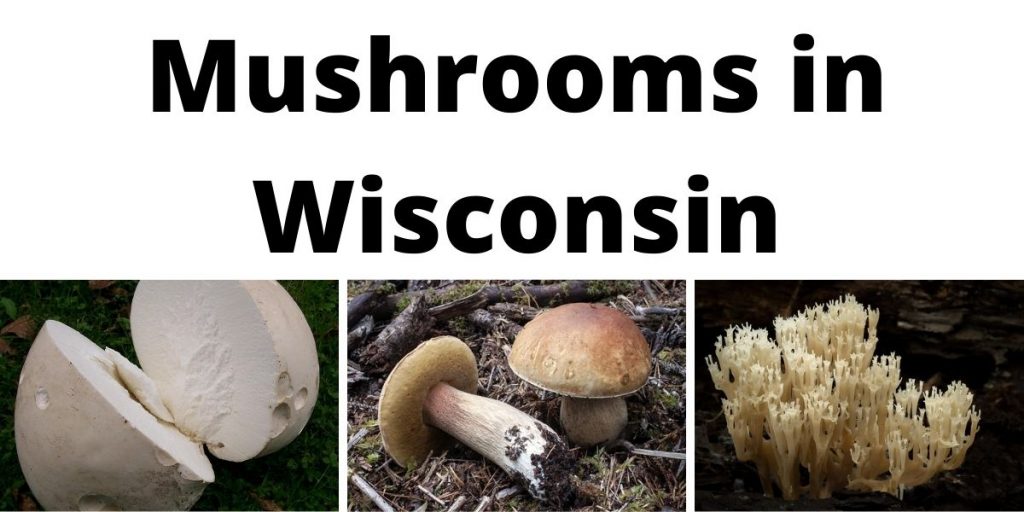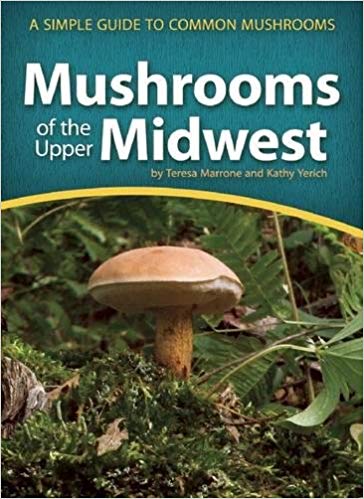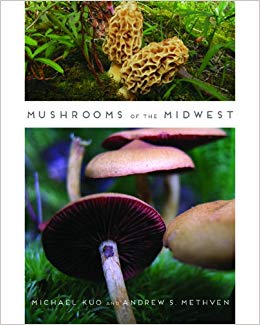Wisconsin is famous for its cheese and its beer not its mushrooms, but it has mushrooms aplenty anyway. Of course, we can’t describe all the mushroom species in the state, but we can explore a few of the more interesting ones—just a taste, so to speak[i].
Speaking of taste, you’ll notice we don’t get into a lot of detail on how these mushrooms look. This article is not intended to get beginners started in foraging—as a general rule, beginners should not forage without the help of an expert. The problem is that until you get really familiar with mushrooms, it’s easy to overlook critical features, making the task of identification much harder. And while most mushrooms are not poisonous, enough of them are to cause a problem for the unwary[ii].
The point of this article is not to get you to skip the learning curve, but to give you a reason to climb up that curve until you are an expert.
If you do indeed go Mushroom Hunting make sure you have the proper tools, take a quality knife with you and a basket/bag for your haul!
This list is not meant to be used as a replacement for a field guide, spore prints, an identification app or an in person guide.
Our Recommended Field Guides for Wisconsin
COVER | TITLE | Header | ||
|---|---|---|---|---|
OUR #1 RATED | ||||
Edible Wild Mushrooms in Wisconsin
Most of the popular groups of edible mushrooms are represented in Wisconsin by at least one or two species, but we have chosen to only cover a few of them. We don’t want the article to be too long so we aim to do a general breakdown of the most common mushrooms.
Meadow Mushroom (Agaricus campestris)
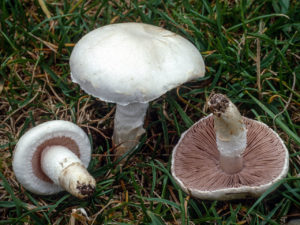

This is a wild relative of that species you find on pizza and so forth, the one variously called white button, crimini, or portobello, depending on its age and variety, but it seems not to have a name that means the whole species. Well, that’s because its common name actually is “mushroom.” So this is the wild version[iii]. Reportedly, it tastes about the same.
This species is a perfect example of why beginners shouldn’t forage alone. It’s a large, white, handsome fungal fruiting body, as are two of the most dangerous species in the state. To an expert eye, the resemblance is slight. To a beginner who is not yet used to noticing distinctive fungal details, the resemblance can look dangerously close.
Boletes
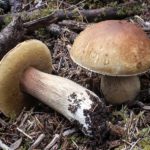

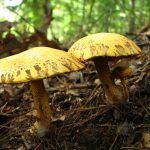



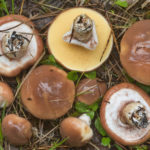

The boletes are a large group of fungi whose fruiting bodies have the classic umbrella-like mushroom shape but lack gills. Instead of gills, they have a flat surface with many small pores. From these pores issue the spores. At one time, all boletes were classified in a single genus, Boletus, but as researchers have learned more about fungal diversity, the group has been split up into many genera, at least two of which have representatives in Wisconsin.
The King Bolete is an interesting case. You’ll see it listed as Boletus edulis, a name originally given to a European species. Whether any of the very similar-looking mushrooms found in North America really belong to the same species as initially supposed is not clear[iv]. Certainly there is more than one species of American king, though it may be too soon to say which one grows in Wisconsin. In any case, all of the kings are choice edibles.
Other Wisconsin species in the group include several members of the genus, Suillus. Chicken fat (Suillus americanus)[v] is so called because it’s yellow and slimy. If cooked properly, it can become tasty, but it’s not considered choice. Some people get a rash from handling it raw. Weeping bolete (S. granulatus)[vi] is so called because drops of white fluid come from its pores. It is safe to eat for most people, but does bother some stomachs. Reportedly, it’s not very good. Slippery jack (S. luteus)[vii] is slimy on top when wet, hence the name—a name sometimes used to refer to a number of other slimy species. Again, it’s usually safe to eat when cooked, but does bother some people, and no one seems to like its taste very much. However, like Wisconsin’s other Suillus species, it often fruits in very large numbers and could therefore provide a lot of food.
Giant Puffball (Calvatia gigantea)
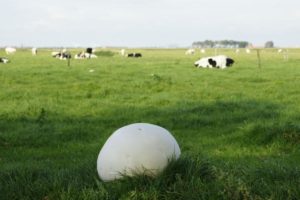

The giant puffball is aptly named; the thing can get as big as a basketball. It’s a well-regarded edible, though its protein content is so high it goes bad if not refrigerated, just like meat. The fluffy texture is a bit odd, so some people like to dry it, powder it, and then use it to thicken soups. It’s important to inspect the interior of any puffball carefully before cooking to make sure it is still plain, homogeneous, white. As the spores start to mature, the puff discolors and then darkens, a sign that the ball is no longer edible. There are also poisonous species that can resemble a puffball when young, and the only way to tell the difference is to slice the ball open, but a full-size giant is bigger than such look-alikes.
Crown-Tipped Coral Fungus (Clavicorona pyxidata)
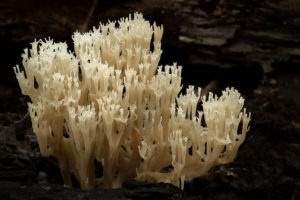

Coral fungi are an interesting group; their fruiting bodies consist of small clumps of many upright, branching stalks, rather like some corals. Most are not closely related to each other, despite their similarity. This one[viii], known by the tiny projections at the tips of its branches, like the points of a crown. This species is also safe to eat for most people—for some, it can cause serious gastrointestinal upset. Tasted raw, it develops a hot, peppery taste after some seconds (like most fungi, the crown-tipped coral shouldn’t ever be eaten raw). The spiciness may or may not survive cooking. This fungus is prized among mycophiles for its texture.
Inky Caps


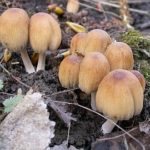

The inky caps don’t seem like they should be popular table fare. For one thing, older specimens, or those stored after picking for any length of time, quickly turn into black goo. For another, in some species, most individuals contain a substance that impairs the breakdown of alcohol in the body, making anyone who drinks alcohol within a few days of eating the mushroom very ill. But many (not all) ink caps are edible, and some are prized. You just have to collect them young and cook them quickly, before they go gooey (the goo is not toxic and actually can be used as food coloring). Curiously, although once all classified in the same genus, it turns out that the ink-caps are not closely related and are now distributed across multiple genera in at least two different families.
Wisconsin has at least two species of inky caps. Shaggy mane (Coprinus comatus) is indeed somewhat shaggy. It does not interfere with alcohol[ix], and is very popular as food[x]. Glistening Ink Cap, or Mica Ink Cap (Coprinellus micaceus)[xi] has shiny little flecks on the cap when young. It is at least suspected of interfering with alcohol[xii], and it is quite bland in flavor, but it is edible.
Velvet Foot (Flammulina velutipes)
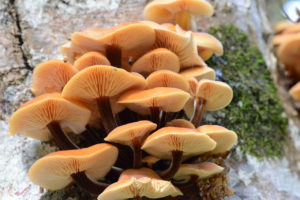

Velvet foot[xiii] gets its name from the fuzzy base of its stem. An alternate name, winter mushroom, is apt; it will fruit in winter even in Wisconsin. It’s widely considered delicious, but it looks very much like, and sometimes grows mixed in with, the Deadly Galerina. Don’t eat this one unless it was picked by a very cautious expert.
Curiously, while velvet foot usually produces mushrooms with broad, red-brown caps, if grown in the dark with limited fresh-air exchange, the mushrooms end up white and string-like, with tiny caps, looking like a completely different mushroom. The species is cultivated to produce the white form, which is widely available under its Japanese names, Enoki or Enokitake.
Poisonous Mushrooms in Wisconsin
There is no simple rule for avoiding poisonous mushrooms, no easy way to tell which are safe to eat and which are not. This doesn’t stop people from offering simple rules to the public, but following those rules can get you killed because the mushrooms themselves don’t follow them. It may be that most edible mushrooms have this or that characteristic, but whatever it is, there’s at least one poisonous species that has it too. And it may be that most toxic species have this or that trait, but whatever it is, there are toxic species that don’t have it, too (and edible ones that do). There is simply no substitute for learning to recognize individual mushroom species and learning which are safe to eat.
It’s worth noting, too, that there is a large gray area between edible and toxic mushrooms—there are mushrooms that are toxic sometimes, for some people, under some circumstances, but some people have eaten them with no ill effects. It’s not always clear what the difference is. There’s also some legitimate debate over what constitutes a toxin. For example, are the “magic” mushrooms toxic? Psychonauts would say no, and indeed we list them separately, too. But hallucinating without expecting to could be very disturbing, even dangerous, and those mushrooms can have unpleasant—and occasionally quite dangerous—side-effects. And there are fungi that are hallucinogenic and are also toxic by anybody’s definition.
So if you find a website that lists a species you know to be edible or “magic” as toxic, don’t be quick to assume the author is just trying to ruin your fun. Find out more, before you sample the thing.
Destroying Angel
“Destroying angel” is the common name of several very similar extremely toxic species. Amanita Bisporigera is Wisconsin’s species. Sometimes you’ll see it listed as Amanita verus, which is actually the European destroying angel. All the angels are big, handsome, white or whitish gilled mushrooms capable of killing people who eat it. Proper treatment can save some (not all) victims, but since symptoms can take a day or more to appear, diagnosis is difficult. Symptoms resolve on their own after a few days, a fact that can confuse doctors—then major organs fail.
Destroying angels are very distinctive-looking, but not so distinctive that an inexperienced or inattentive forager can’t make a mistake. In fact, they have been mistaken for a great many edible species, including meadow mushroom, shaggy parasol, ink caps, and, when very young, puffballs.
Deadly Galerina (Galerina marginata)
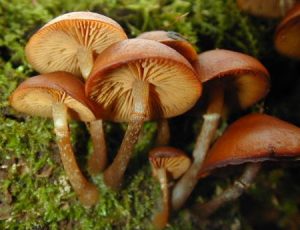

Deadly galerina contains the same toxin as the destroying angel, though the two are not closely related. Worse, it is not distinctive-looking at all; it’s a nondescript little brown mushroom just like any number of popular edible species and most of the magic mushrooms. “Hey, this looks just like the things my cousin grows!” have probably been the last words of quite a few people.
And the really scary thing is that deadly galerina shares a habitat with—and can grow in mixed clusters with some of its popular look-alikes, such as velvet-foot, some of the honey mushrooms, and some of the psychoactive species. It’s not enough to carefully identify most mushrooms in a clump. Every single mushroom headed for a human mouth must be double-checked because the one that isn’t checked could be the deadly galerina.
Note that at one time there were thought to be several deadly galerina species, so you may see it listed by several scientific names. Actually, there is just the one. It simply grows everywhere.
Torn Fibercap (Inocybe rimosa)


Fibercaps[xiv] are a group of nearly-identical mushrooms within the large, nondescript category of little brown mushrooms. And they’re poisonous. The toxin can kill humans, but is treatable with drug therapies. They are another reason to be careful with identifying little brown mushrooms.
Fly Agaric (Amanita muscaria)
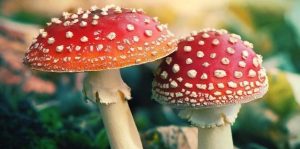

Fly agaric, often referred to by its scientific name, is well-known as a psychoactive species and is sometimes used for recreational or spiritual purposes—it is a beautiful and very distinctive mushroom, not easily mistaken for anything else, so people who eat it usually do so on purpose. However, its psychoactive principle is not psilocybin but rather a different, more dangerous substance, plus it includes other toxins, including the same toxin that is present in the fiber caps. Proper processing can reduce the toxic load enough for more or less safe use, and we have listed it among the “magic” mushrooms before, but a mistake in processing could be very dangerous. Poisoning is not usually deadly, but can be.
False Parasol (Chlorophyllum molybdites)
False parasol is an interesting case. It’s often spoken of as though it were a poisonous look-alike of the edible shaggy parasols. Actually, some of the shaggy parasols are poisonous sometimes, while the false parasol has been eaten without incident on occasion. It may be more accurate to say that the false parasol is simply one end of a continuum from safe to toxic among a group of closely-related and very similar-looking species.
False parasol won’t usually kill you if you eat it, but will make you feel very, very bad. Cases of mistaken identity involving this mushroom are extremely common—it may be the most common cause of mushroom poisoning in the United States.
Magic Mushrooms in Wisconsin
“Magic” mushrooms are generally those that contain psilocybin, a relatively safe—but not risk-free—psychoactive substance whose possession and use is against both Federal and Wisconsin law[xv]. The best-known are species in the genus, Psilocybe, especially Psilocybe cubensis, which is widely cultivated. It’s not clear whether any Psilocybes grow wild in Wisconsin, but several other psychoactive mushrooms do[xvi]. Please do not use any of this information to get arrested. Also, do not harvest wild “magic” mushrooms if you are not an expert at mushroom identification—there are some extremely toxic look-alikes. Human fatalities have follows from people eating what they thought were psychoactive mushrooms but weren’t.
Banded Mottlegill (Panaeolus cinctulus)
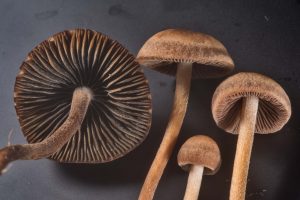

The mottlegills are a group of little brown mushrooms whose spores develop unevenly, giving the gills a patchy-mottled appearance. Some are psychoactive, some are not. The banded mottlegill is mildly but definitely psychoactive, giving a high reportedly similar to that of the better-known psilocybes.
Gymnopilus sp.
The Gyms are not commonly used and the definition of species within the group is a bit unclear. Reportedly, the high is qualitatively different from that of the psilocybes, suggesting some sort of biochemical distinction.
Pholiotina smithii
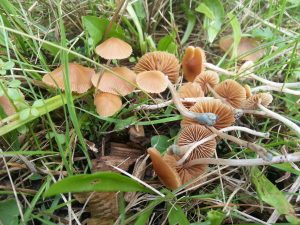

This species is psychoactive, however, it’s impossible to identify with any certainty without microscopic examination—and some of its close look-alikes are toxic, even deadly[xvii]. It’s not clear whether anyone has actually used this species[xviii].
Our Recommended Field Guides for Wisconsin
COVER | TITLE | Header | ||
|---|---|---|---|---|
OUR #1 RATED | ||||
References:
[i] (n.d.). Thirty Edible Mushrooms. Wisconsin Mycological Society
[ii] (n.d.). Ten Poisonous Mushrooms. Wisconsin Mycological Society
[iii] (n.d.). Agaricus campestris L.–Field Mushroom. First Nature
[iv] Kuo. M. (2016). Boletus edulis. MushroomExpert
[v] Volk, T. (2004). Suillus americanus, the Chicken-Fat Mushroom. Tom’s Fungi
[vi] (n.d.). Suillus granulatus (L.) Roussel—Weeping Bolete. First Nature
[vii] (n.d.). Suillus luteus (L.) Roussel—Slippery Jack. First Nature
[viii] Volk, T. (2001). This Month’s Fungus Is Clavicorona pyxidata, the Crown-Tipped Coral Fungus. Tom’s Fungi
[ix] (n.d.). The Inky Cap Mushroom: Can You Safely Eat and Consume Alcohol? Mushroom Huntress
[x] (n.d.). Coprinus comatus (O.F. Müll.) Pers.—Shaggy Inkcap. First Nature
[xi] (n.d.). Coprinellus micaceus (Bull.) Vilgalys, Hopple & Jacq. Johnson—Glistening Inkcap. First Nature
[xii] Clarke, D., Crews, C. (2014). Hazards and Diseases. Encyclopedia of Food Safety
[xiii] Volk, T. (1997). This Month’s Fungus Is Flammulina velutipes, also Known as the Winter Mushroom, Velvet Stem,Velvet Foot, Enoki, Enokitake. Tom’s Fungi
[xiv] (n.d.). Inocybe rimosa (Bull.) P. Kumm.—Torn Fibrecap. First Nature
[xv] Dubley, P. (2022). Are Psychedelics Legal in Wisconsin? Tripsetter
[xvi] (n.d.). Which Psilocybin Mushroom Grow Wild in My Area? Shroomery
[xvii] (n.d.). Pholiotina rugosa: The Ultimate Mushroom Guide. Ultimate Mushroom
[xviii] Motor Juice (2014). Pholiotina smithii? Confirmation Needed. Shroomery


